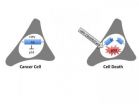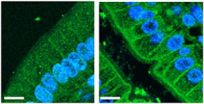(Press-News.org) ANN ARBOR—When we think of ill effects from lead exposure various neurologic problems usually come to mind. Now researchers at the University of Michigan say another health impact can be added to the list: obesity.
Even at low levels, lead is associated with obesity in mice whose mothers were exposed to the chemical, researchers at the U-M School of Public Health found. Specifically male mice exposed to lead had an 8-10 percent increase in weight.
"The data support the obesogen hypothesis that toxicant exposures in the womb contribute to the higher rate of obesity," said Dana Dolinoy, the John G. Searle Assistant Professor of Environmental Health Sciences and senior author of the study. "There are certain chemicals that are considered the hallmarks of the obesity epidemic, and lead has not been not one of them."
The closest previous research has come to tying lead exposure to weight are studies showing decreased fetal and early childhood growth in human infants, and obesity in later life in mice. But the U-M study is the first to look at how what a mother ingests, even before pregnancy, impacts her offspring. Scientists like Dolinoy and those in her lab have found that the crucial beginning of life often is where chemical exposure is most impactful.
The U-M paper, "Perinatal Lead (Pb) Exposure Results in Sex-Specific Effects on Food Intake, Fat, Weight and Insulin Response across the Murine Life-Course," is published in the current issue of PLOS-ONE.
In the study, mothers were exposed to lead through drinking water two weeks before mating then throughout pregnancy and nursing. Their litters were then measured at 3, 6 and 9 months of age for energy expenditure, spontaneous activity, food intake, and body weight and composition. At age 9 months they were tested for glucose tolerance. Researchers determined sex specific impacts on all of the measures.
The groups of mice were exposed to lead at 0.0 parts per million (ppm) for the control group, 2.1ppm, 16ppm or 32ppm. Maternal blood lead levels (BLL) tested at weaning were below the level of detection for the control group, 4.1 (±1.3) micrograms per deciliter (μg/dL), 25.1 (±7.3) μg/dL and 32.1 (±11.4) μg/dL, respectively.
The Centers for Disease Control and Prevention has established a reference level of 5 μg/dL to identify children who have been exposed to lead and require case management. Yet, no safe BLL in children has been identified.
The researchers found:
Starting in early life, males in the two highest exposure groups outweighed the controls, a trend consistent from youth to adulthood.
An increase in body fat at all dosages showed up in males at 3 months of age.
Overall, both sexes exposed to the highest dose ate more than the control group, with males eating more at 6 months of age and female consumption increasing at 9 months of age.
Exposed males showed impaired insulin levels at 9 months of age.
Although females appeared more active for a time, there was no significant increase in spontaneous activity for either sex.
In terms of energy expenditure, both sexes showed the expected decline in oxygen consumption and carbon dioxide production as they aged, but the exposed females had higher energy expenditure at 3 months of age and the exposed males had lower energy expenditure at 9 months of age.
Lead exposure dangers have been noted by members of the scientific community for a number of years, leading to the chemical's ban in items like paint and gasoline. But it still exists in older homes, and in air, water, soil, food and consumer products.
Researchers used the wide range of exposure levels to more closely match with human experience. Baby boomers and other older adults once were exposed to levels much higher, on average, before some of the bans on lead. For example, in 1978 when lead was banned in U.S. paint, the national average BLL was 15 μg/dL, and the CDC "level of concern" was 30 μg/dL. The levels of exposure today are closer to the lower dosage the team used.
Lead author Christopher Faulk, research fellow in the Dolinoy Lab-Environmental Epigenetics and Nutrition, said prior to the study he did not fully appreciate the dangers of the exposure most of us have to lead.
"To see that the level I and others have considered very low has such statistical significance in this study is alarming. There is no minimum safe level for lead. Our research really supports this," he said.
INFORMATION:
Other U-M School of Public Health authors were: Amanda Barks, Olivia Anderson and Karen Peterson, Department of Environmental Health Sciences, and Brisa Sánchez and Zhenzhen Zhang, Department of Biostatistics. Peterson also represents the Center for Human Growth and Development at U-M and the Department of Nutrition at Harvard School of Public Health.
The current research was supported by the Environmental Protection Agency/National Institute of Environmental Health Sciences U-M Children's Environmental Health Formative Center, the National Institute of Diabetes and Digestive and Kidney Diseases Michigan Nutrition Research Obesity Center, and the National Institute of Environmental Health Sciences Core Center of Excellence
The article (live at embargo lift): http://dx.plos.org/10.1371/journal.pone.0104273
U-M Formative Children's Environmental Health and Disease Prevention Center: http://sitemaker.umich.edu/cehc/home
U-M NIDDK Nutrition Obesity Research Center: http://mmoc.med.umich.edu
U-M NIEHS Environmental Health Sciences Core Center: http://ehscc.umich.edu
Dolinoy Lab: http://bit.ly/1pARqnV
Dana Dolinoy: http://bit.ly/UZ0O9s
Lead linked to obesity in mice exposed by mothers
2014-08-08
ELSE PRESS RELEASES FROM THIS DATE:
Disney Researchers develop method to capture stylized hair for 3-D-printed figurines
2014-08-08
Perhaps no aspect of 3D printing has captured the popular imagination more than personalized figurines with the facial features of real people. Now, researchers at Disney Research Zurich and the University of Zaragoza have developed a method that can incorporate an individual's hairstyle as well.
The researchers will present their new method at ACM SIGGRAPH 2014, the International Conference on Computer Graphics and Interactive Techniques in Vancouver, Aug. 10-14.
Miniature statues with a person's likeness are nowadays produced by scanning the individual's face with ...
Expecting to teach enhances learning, recall
2014-08-08
"When compared to learners expecting a test, learners expecting to teach recalled more material correctly, they organized their recall more effectively and they had better memory for especially important information," said lead author John Nestojko, PhD, a postdoctoral researcher in psychology in Arts & Sciences at WUSTL.
The study, published recently in the journal Memory & Cognition, is based on a series of reading-and-recall experiments in which one group of students is told they will be tested on a selection of written material, and another group is led to believe ...
Water's reaction with metal oxides opens doors for researchers
2014-08-08
MADISON, Wis. — A multi-institutional team has resolved a long-unanswered question about how two of the world's most common substances interact.
In a paper published recently in the journal Nature Communications, Manos Mavrikakis, professor of chemical and biological engineering at the University of Wisconsin-Madison, and his collaborators report fundamental discoveries about how water reacts with metal oxides. The paper opens doors for greater understanding and control of chemical reactions in fields ranging from catalysis to geochemistry and atmospheric chemistry.
"These ...
Editing HPV's genes to kill cervical cancer cells
2014-08-08
DURHAM, N.C. -- Researchers have hijacked a defense system normally used by bacteria to fend off viral infections and redirected it against the human papillomavirus (HPV), the virus that causes cervical, head and neck, and other cancers.
Using the genome editing tool known as CRISPR, the Duke University researchers were able to selectively destroy two viral genes responsible for the growth and survival of cervical carcinoma cells, causing the cancer cells to self-destruct.
The findings, appearing online August 7 in the Journal of Virology, give credence to an approach ...
UK study shows promise for new nerve repair technique
2014-08-08
LEXINGTON, Ky. (Aug. 8, 2014) – A multicenter study including University of Kentucky researchers found that a new nerve repair technique yields better results and fewer side effects than other existing techniques.
Traumatic nerve injuries are common, and when nerves are severed, they do not heal on their own and must be repaired surgically. Injuries that are not clean-cut – such as saw injuries, farm equipment injuries, and gunshot wounds – may result in a gap in the nerve.
To fill these gaps, surgeons have traditionally used two methods: a nerve autograft (bridging ...
Ancient shellfish remains rewrite 10,000-year history of El Nino cycles
2014-08-08
The planet's largest and most powerful driver of climate changes from one year to the next, the El Niño Southern Oscillation in the tropical Pacific Ocean, was widely thought to have been weaker in ancient times because of a different configuration of the Earth's orbit. But scientists analyzing 25-foot piles of ancient shells have found that the El Niños 10,000 years ago were as strong and frequent as the ones we experience today.
The results, from the University of Washington and University of Montpellier, question how well computer models can reproduce historical El ...
Kessler Foundation scientists confirm effectiveness of cognitive rehabilitation in MS
2014-08-08
WEST ORANGE, NJ August 8, 2014. Kessler Foundation researchers published long-term followup results of their MEMREHAB trial, which show that in individuals with MS, patterns of brain activity associated with learning were maintained at 6 months post training. The article, A pilot study examining functional brain activity 6 months after memory retraining in MS: the MEMREHAB trial, was published online ahead of print on June 14 by Brain Imaging and Behavior (doi: 10.1007/s11682-014-9309-9). The article appeared in the Neuroimaging and Rehabilitation Special Issue. The authors ...
Photo editing algorithm changes weather, seasons automatically
2014-08-08
PROVIDENCE, R.I. [Brown University] — We may not be able control the weather outside, but thanks to a new algorithm being developed by Brown University computer scientists, we can control it in photographs.
The new program enables users to change a suite of "transient attributes" of outdoor photos — the weather, time of day, season, and other features — with simple, natural language commands. To make a sunny photo rainy, for example, just input a photo and type, "more rain." A picture taken in July can be made to look a bit more January simply by typing "more winter." ...
Natural light in office boosts health
2014-08-08
CHICAGO -- Office workers with more light exposure at the office had longer sleep duration, better sleep quality, more physical activity and better quality of life compared to office workers with less light exposure in the workplace, reports a new study from Northwestern Medicine and the University of Illinois at Urbana-Champaign.
The study highlights the importance of exposure to natural light to employee health and the priority architectural designs of office environments should place on natural daylight exposure for workers, the study authors said.
Employees with ...
New culprit identified in metabolic syndrome
2014-08-08
A new study suggests uric acid may play a role in causing metabolic syndrome, a cluster of risk factors that increases the risk of heart disease and type 2 diabetes.
Uric acid is a normal waste product removed from the body by the kidneys and intestines and released in urine and stool. Elevated levels of uric acid are known to cause gout, an accumulation of the acid in the joints. High levels also are associated with the markers of metabolic syndrome, which is characterized by obesity, high blood pressure, elevated blood sugar and high cholesterol. But it has been unclear ...




